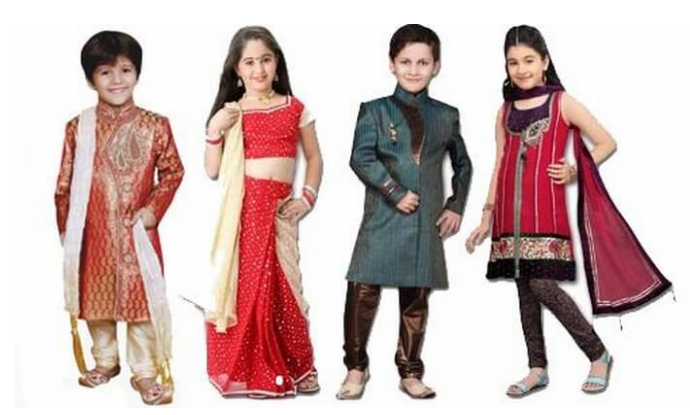Kids Traditional Fashion
Kids’ traditional fashion in India is a delightful blend of comfort, color, and cultural heritage. For festive occasions, weddings, and traditional celebrations, children often wear mini-versions of classic Indian outfits that are designed with playful patterns and vibrant colors to suit their age and add charm to the occasion. Here are some popular traditional attire options for kids in India:
Lehenga Choli for Girls: Inspired by adult styles, the lehenga choli for girls includes a flared skirt (lehenga), a fitted blouse (choli), and a dupatta (scarf). Available in bright colors and light fabrics, these outfits are ideal for weddings and festivals like Diwali and Navratri. Designs often incorporate mirror work, floral prints, or embroidery, making them festive yet comfortable.
Ghagra Choli for Girls: Similar to the lehenga choli, the ghagra choli is a traditional choice for young girls, especially in Gujarat and Rajasthan. Decorated with mirrors, embroidery, and sometimes tie-dye or Bandhani patterns, this outfit is a favorite for Navratri and Garba dance celebrations.
Sarees for Girls: Although typically an adult garment, sarees for young girls are often pre-stitched or draped in a way that is easy to wear. Lightweight fabrics like cotton or silk are used, with bright colors and simple embellishments, allowing young girls to enjoy the look of a saree while staying comfortable.
Salwar Kameez and Anarkali Suits for Girls: These are comfortable and elegant options for young girls, combining traditional style with ease of movement. The salwar kameez includes a long tunic with loose pants, while the Anarkali is a frock-style dress paired with churidar pants. Often adorned with delicate embroidery, sequins, or lace, they are ideal for any cultural event.
Kurta Pajama and Sherwani for Boys: The classic kurta pajama is a popular traditional outfit for boys. It includes a long tunic (kurta) and comfortable pants (pajama), available in vibrant colors and lightweight fabrics. For more formal occasions like weddings, young boys may wear sherwanis—embellished jackets with intricate designs, paired with churidar pants.
Dhoti Kurta for Boys: Inspired by the traditional attire of many Indian states, the dhoti kurta set is a charming outfit for young boys. It includes a dhoti, which is a wrap-around lower garment, and a kurta (long tunic). The outfit is especially popular in South Indian and Bengali communities, often worn for religious and cultural events.
Pavadai/ Langa Voni for Girls: This traditional South Indian attire consists of a long skirt (pavadai) and a blouse (langa). For older girls, it may include a half-saree drape called “voni.” This outfit, usually crafted from silk or cotton, is worn for festivals like Pongal and weddings in states like Tamil Nadu and Andhra Pradesh.
Angrakha Style Kurta for Boys: Inspired by Rajasthan’s royal heritage, the angrakha kurta features an overlapping design tied with strings on one side. Paired with pajamas or dhotis, this outfit adds a regal touch to a boy’s traditional wardrobe, making it popular for family gatherings and cultural events.
Jewelry and Accessories: Kids’ traditional outfits are often accessorized with minimal jewelry, such as small bangles, anklets, and bindis for girls. Boys may wear small turbans or caps, especially in North India, where the pagdi (turban) is a sign of honor and cultural pride.
Footwear: Traditional footwear like mojris or juttis, which are embroidered slip-on shoes, are popular with kids’ traditional attire. They come in a range of colors and patterns that complement traditional outfits.
As Indian families continue to cherish their cultural heritage, kids’ traditional fashion has become a mix of comfort and authenticity, ensuring that children can participate in festivities in style while being comfortable. Many parents are also leaning towards sustainable, handcrafted outfits, ensuring that kids’ clothing is both eco-friendly and connected to India’s artisan heritage.

